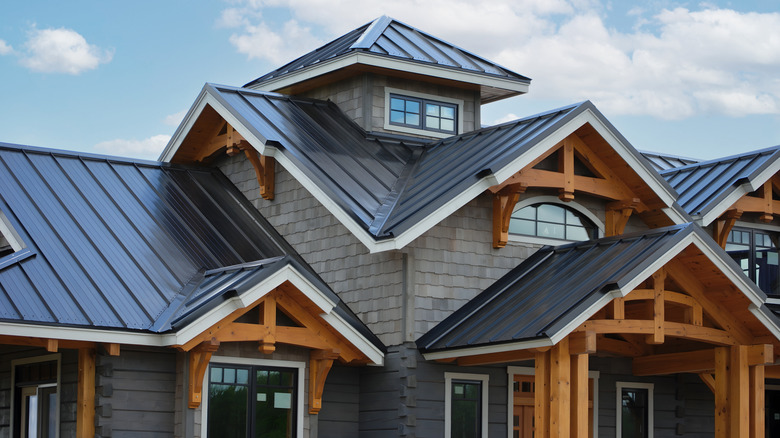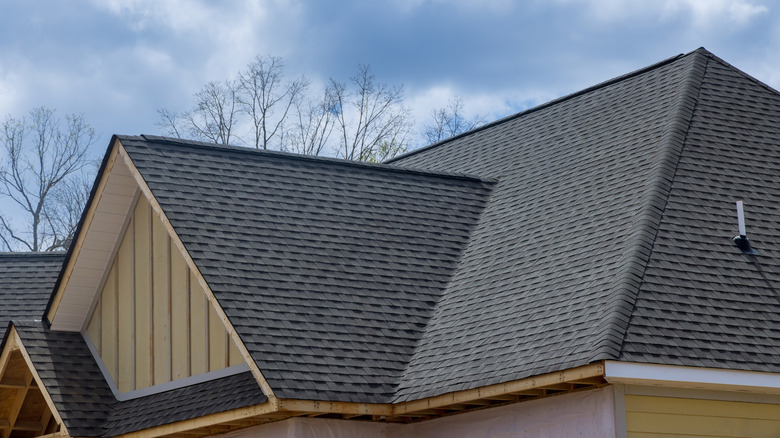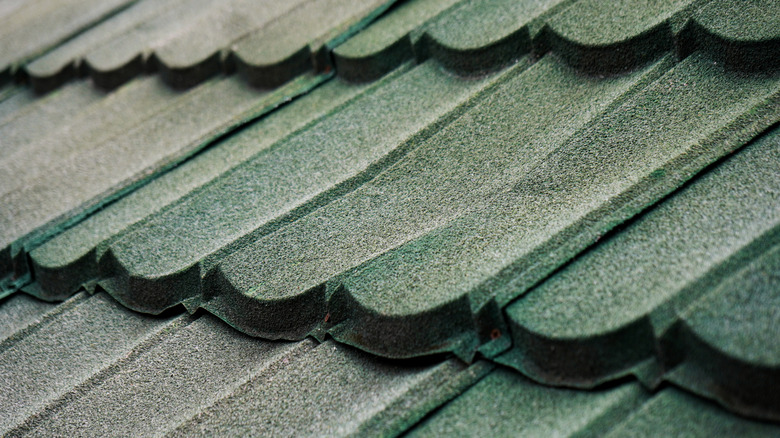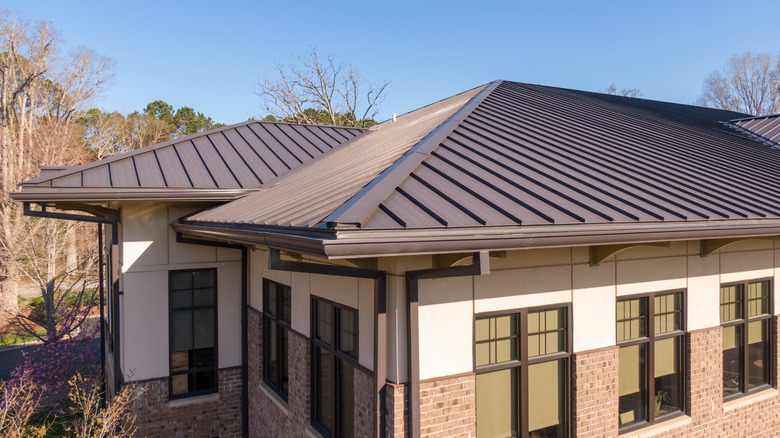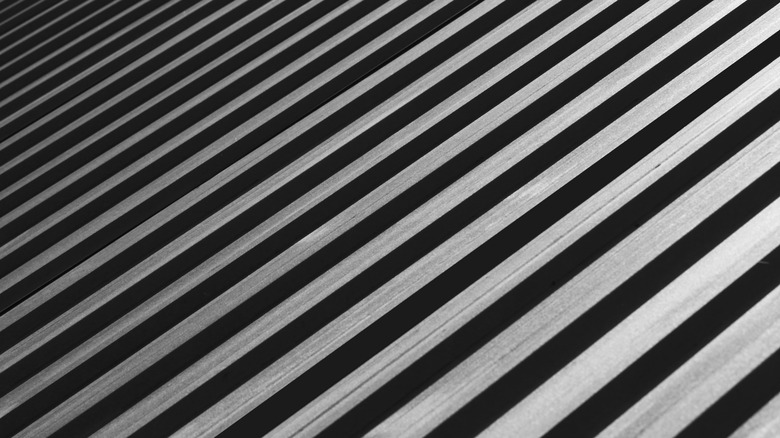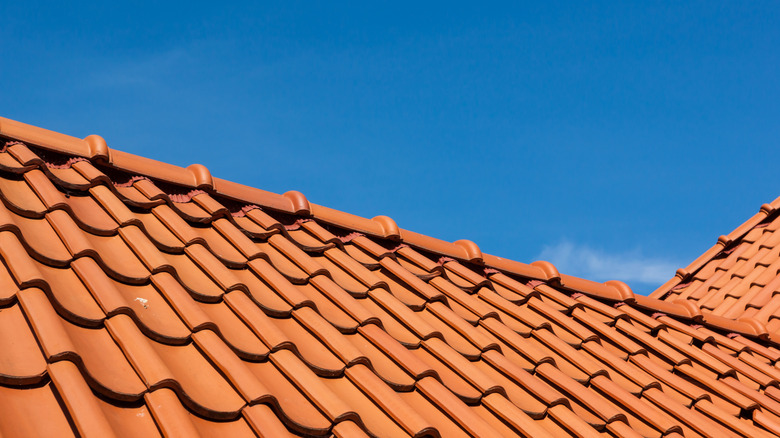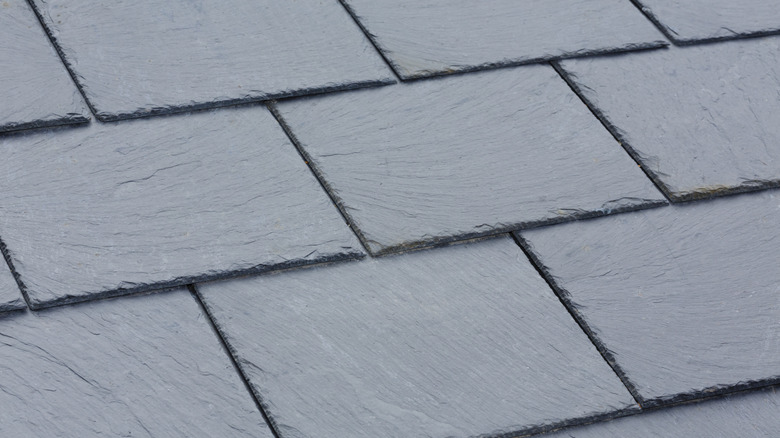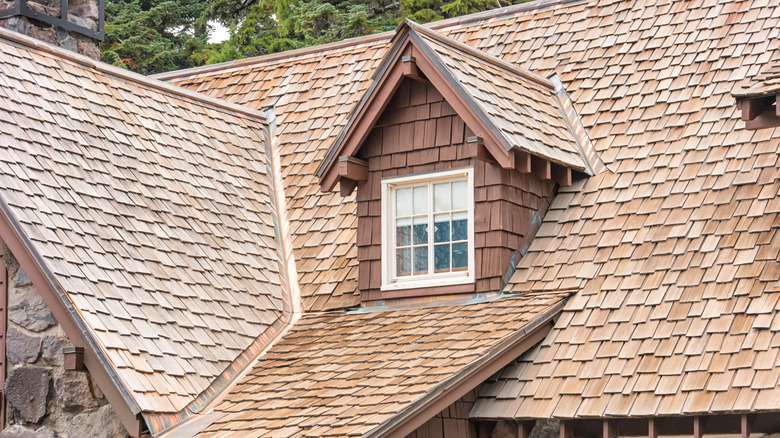Downsides Of The Most Popular Roofing Materials
We may receive a commission on purchases made from links.
There are dozens of roofing materials to choose from and each one has its upsides and downsides. This investment shouldn't be taken lightly — a roof is the primary bulwark standing between an interior and the outside world. Roofing made from the same material can vary in quality, but there are general features of stone, synthetics, wood, and other mixtures that make roof types more or less suited for certain areas. It's essential that homeowners choose materials that best fit their climate, aesthetic, and willingness for upkeep.
Below are eight popular roof materials used on homes. We discuss what the material is and its most commonly reported issues, as well as how it holds up compared to other popular roofs. In addition to the downsides, we also cover popular solutions and workarounds for the known cons of each material. Read on to also learn why these roofs remain popular despite any setbacks caused by their material. There are many differences in roof types, such as metal roofs vs. asphalt shingles, so it's important to narrow down which roof is the best option for certain situations. This helps with picking the best roof for your home, while considering the available budget and present environment.
Asphalt shingles are extremely common and lack individuality and longevity
The downsides of asphalt shingles are more well-known than those of other roofing types because asphalt shingles are so popular. These shingles consist of a fiberglass base with a blend of asphalt granules, fiberglass, and tar on top. Over years of exposure to wind and rain, the granules dissipate, and these roofs start looking run down after just two decades. Bill Ragan Roofing Company claims that asphalt shingle roofs typically last up to 80% of the maximum time stated by their manufacturer. You aren't going to spend as much for the initial installation, but you will need a roofing renovation much sooner than more expensive roof alternatives. All in all, asphalt shingles just aren't the most durable roofing material out there, but they still get the job done for decades.
Many United States neighborhoods are dominated by asphalt shingle-style roofing. This isn't because asphalt is superior to other materials, but rather that it's easy to find and affordable to install. At about $3 to $5.50 per square foot, it's a steal compared to more heavyweight and luxurious roofing styles. Another bonus is that asphalt shingles only weigh about 2 to 4 pounds per square foot, making them cheaper to transport and maneuver during the construction process, as compared to heavier materials like slate.
Composite shingles seem superior, but haven't been around long enough to be sure
Composite shingles are a synthetic invention often comprised of recycled asphalt, fiberglass, metal, paper, plastic, or rubber. It's incredibly durable, holding up to weather conditions like wind and hail, as well as external factors like fire. However, this material is relatively new to the roofing industry, so only short-term studies have been done. Professionals believe it can last up to 50 years, but the true lifespan is a matter for debate since synthetic roofs just started rising in popularity.
Even though composite shingles have only been around a few decades, many brands hold up well. They only cost $4 to $8 per square foot, making them almost as affordable as traditional asphalt shingles. The weight, style, and color varies depending on the material composition, giving you the freedom to seek out the look and weight you want. Since many composite roof materials are made from recycled waste, including repurposed asphalt granules, they are a great eco-friendly option for those who lean towards greener practices.
Steel roofing is an expensive and loud, but long-lasting, option if you don't live on the coast
Steel roofing is more common in commercial buildings, but it's also a great option for homeowners with higher budgets. Steel roofing has a median price point of around $8 to $13 per square foot. This price varies depending on the style of installation: standing seam or screw-down panels (also known as exposed fasteners). Screw-down panels are more affordable, but the screws must be replaced every few years since they get dislodged and damaged by fluctuating temperatures. The reason screws get dislodged is that as metal gets too cold or hot, it expands and contracts, causing it to rub against the screws throughout the year.
Another downside to steel roofing is that it's loud. Rain, hail, and falling debris clang against this style of roofing, echoing throughout an entire home. The sound can be somewhat muffled by insulation, but will still be louder than one would notice with other roofing materials. It's also recommended to think twice if in a coastal area — warranties are sometimes voided in these areas due to moisture concerns, since high humidity and rainfall can cause rusting and degradation to steel roofs.
Don't write off steel roofs just yet, though. Despite the disadvantages, steel roofing can last up to 80 years and greatly improve household energy efficiency. An unpainted metal roof directly reflects the sun's rays, diminishing how much heat is absorbed by your home. Metal roofs also more easily release the heat they do absorb (this is called thermal emittance). These roofs are also often made of recycled metals and can be recycled after use, making them extra eco-friendly in that regard.
Aluminum roofing is doable in coastal areas, but is more prone to dents
Steel roofing isn't ideal for coastal climates, but there is a potential metal roof material that works as an alternative: aluminum. Though they fit that bill, they have their own list of downsides. They cost around the same as steel roofs, at about $8 to $12 per square foot, but are much softer in composition. It's more prone to dents from storm damage and falling debris, though this can be offset if you invest in a more expensive and denser aluminum material. As with steel roofs, they also come in two forms, and if you go with screw down panels, you'll get a cheaper estimate, but be responsible for replacing the screws as they degrade over time. These roofs are also prone to "oil canning", which is when the surface becomes damaged and develops a wave-like appearance.
The best perk of aluminum roofing is that it doesn't rust like other metal materials (rust is iron oxide, and aluminum contains very little iron), which is why it's better suited for those who want a metal roof for a coastal home. It's also extremely lightweight, around 5 pounds per square foot, making transporting and installing the materials much easier — in addition to being less weight on your house. On another positive side, aluminum roofs share steel's reflective properties, making them highly energy efficient. Lastly, aluminum roofs will last upwards of 50 to 70 years.
Concrete roof tiles are extremely heavy and need a strong foundation to hold them
Concrete roofs are another material commonly associated with commercial buildings. They can also be used on homes, though there are some problems you may encounter with concrete roof tiles. Concrete is extremely heavy, around 9 1/2 to 12 pounds per square foot, and therefore needs a strong structural base. If you have an older or manufactured home, it's usually not an option. This material is also highly absorbent and can absorb up to 13% of water. When it absorbs moisture, it gets heavier, making the aforementioned point even more essential. Plus, all that moisture can lead to issues with mildew growth or cracking. Although concrete lasts 50 years or more, its underlayment doesn't have the same longevity. You may need to repair this layer in 20 years, regardless of the state of the topmost concrete surface. This roofing is also not advised for those that live in climates where hail is common, or for those in earthquake-prone areas, as both environmental factors can lead to cracks and breaks.
Aside from all the negatives, you should still consider concrete if you're looking for a formidable roof for a modern home on a budget. This roofing material starts at about $3 per square foot. Concrete seems like a boring choice at a glance, but the truth is that there are many aesthetic options. The design can emulate clay, slate, stone, or wood material with molding and painting, giving homeowners more creative freedom.
Terra cotta or clay tile roofs tend to crack in very cold climates
Terra cotta and clay tile roofs aren't just part of Mediterranean architecture for appearance purposes. These materials do not hold up well in severe cold and can crack, making them a much better fit for warmer temperature areas. They're very heavy, between 6 to 15 pounds per square foot, so they're fragile during the installation process. Since they have a similar weight range as concrete, Roof Repair Specialist Wwner Andre Afsharian tells House Digest exclusively, "Your home's structure must be able to handle the extra weight, which may require structural reinforcement. If your home wasn't originally built for tile, the additional work can add to the cost." These roofs aren't cheap, even if you don't have to alter the foundation beforehand to support it, usually ranging around $12 to $25 per square foot. They also require a waterproofing membrane and are not doable on sharp-pitched roofs. Homeowners also must take extra care to safely walk on and clean clay roofs.
Terra cotta and clay roof tiles have been commonplace for thousands of years despite these cons. There's a reason civilization continues to use this material for aesthetic and functional reasons. Clay tiles have a distinctive look that improves your home's appearance and adds curb appeal. They naturally reflect UV rays, boosting energy efficiency, and deter potential pests and insects, which can't eat through or nest in the material. Plus, terra cotta isn't prone to rotting or mildew growth.
Slate roofing must only be installed by experienced and knowledgeable experts
Slate rooftops are built from quarried rock and are popular in luxury homes throughout the United States. Only specific contractors have the experience, knowledge, and skills to install slate roofing, as there is a lot to know about these roof tiles before installing, making it difficult to source the material and right workers for the job. The tiles weigh between 8 to 15 pounds per square foot. This material is dangerous to walk on, making it difficult for contractors to install and for you to tread on when maintaining your own roof. It's also an installation reserved for those with a hefty budget, as it costs up to $30 per square foot for the materials and installation.
Slate roofs take work to install, but once finished, they can last up to 100 years. Since slate tiles are naturally mined, they don't come with manufacturer warranties, so you'll need to rely on the workmanship warranty from your roofing contractor if anything goes wrong. The high cost is for a reason; this material is naturally resistant to fire, rain, and wind, making it easy to withstand the elements, even in areas that face severe weather conditions on a regular basis. Slate doesn't absorb moisture easily, making it resistant to water damage as well as fungus and mold growth that often accompany that problem.
Cedar wood shingles are made-to-order and aren't widely available
Natural wood seems to dominate most manufacturing industries, making it an inevitable resource in roofing too. Cedar wood shakes are expensive at around $8 to $15 per square foot and are difficult to source for initial installations. Good quality cedar is harvested and made to order — manufacturers usually don't keep a lot on hand since fresh-cut wood doesn't last long without treatments. It can take up to two months to get the material, making a roofing project much longer than you may have initially expected. Unlike slate and metal, wood is highly susceptible to moisture, and therefore fungi and mold growth. You may need treatments every few years to remove fungus and moss so it doesn't spread and destroy your roofing.
These downsides seem daunting, but there are other things to know about wood shingles that may lean more toward your favor. Cedar shake's largest selling point is that it's a natural material, meaning there are no synthetic materials or chemicals (as long as you're meticulous about other aspects of the installation). This makes it a safer option for people who are concerned about potential carcinogens and toxins in most manufacturing materials. If you go with 100% straight grain shingles, you'll have the most long-lasting durability as compared to common cedar shingles, which have imperfections. Of course, straight grain shakes do come at a higher cost.
